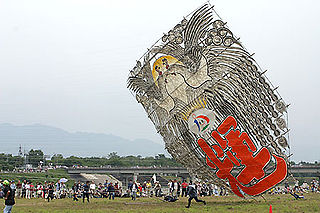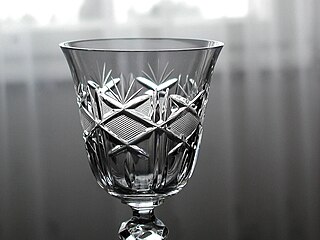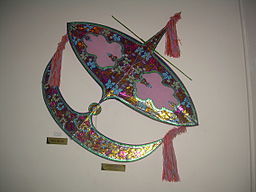
A kite is a tethered heavier-than-air or lighter-than-air craft with wing surfaces that react against the air to create lift and drag forces. A kite consists of wings, tethers and anchors. Kites often have a bridle and tail to guide the face of the kite so the wind can lift it. Some kite designs do not need a bridle; box kites can have a single attachment point. A kite may have fixed or moving anchors that can balance the kite. The name is derived from the kite, the hovering bird of prey.

A fixed-wing aircraft is a heavier-than-air flying machine, such as an airplane, which is capable of flight using wings that generate lift caused by the aircraft's forward airspeed and the shape of the wings. Fixed-wing aircraft are distinct from rotary-wing aircraft, and ornithopters. The wings of a fixed-wing aircraft are not necessarily rigid; kites, hang gliders, variable-sweep wing aircraft and airplanes that use wing morphing are all examples of fixed-wing aircraft.

The art of paper cutting in China may date back to the 2nd century CE, when paper was invented by Cai Lun, a court official of the Eastern Han dynasty.

Chinese folk art or Chinese handcrafts are artistic forms inherited from a regional or ethnic scene in China. Usually there are some variation between provinces. Individual folk arts have a long history, and many traditions are still practiced today. The general definition of folk art incorporates Chinese art forms that are not classified as Chinese fine art.

Kelantan is a state in Malaysia. The capital, Kota Bharu, includes the royal seat of Kubang Kerian. The honorific name of the state is Darul Naim. Kelantan is the only state outside of East Malaysia that does not use the term district in its second-level administrative division. Instead, the districts is named as colonies or collectivities and one autonomous subdistrict.

Kuih are bite-sized snack or dessert foods commonly found in Southeast Asia and China. It is a fairly broad term which may include items that would be called cakes, cookies, dumplings, pudding, biscuits, or pastries in English and are usually made from rice or glutinous rice. In China, where the term originates from, kueh or koé (粿) in the Min Nan languages refers to snacks which are typically made from rice but can occasionally be made from other grains such as wheat. The term kuih is widely used in Malaysia, Brunei, and Singapore, kueh is used in Singapore and Indonesia, kue is used in Indonesia only, all three refer to sweet or savoury desserts.

The Istana Budaya or also known as the Palace of Culture, is Malaysia's main venue for all types of theatre including musical theatre, operetta, classical concerts and opera from local and international performances. It is located in the heart of Kuala Lumpur city, next to the National Art Gallery.
The regalia of Malaysia includes all the items which are deemed sacred and symbolic of the supremacy and authority of the Yang di-Pertuan Agong or the Supreme King of Malaysia and his consort, the Raja Permaisuri Agong. The installation of the Supreme King is a very special ceremony. Only on this particular day are the masses able to see his regalia. Several of these are Malaysian National Treasures since 2009.

Malaysian batik is batik textile art in Malaysia, especially on the east coast of Malaysia. The most popular motifs are leaves and flowers. Malaysian batik depicting humans or animals are rare because Islam norms forbid animal images as decoration. However, the butterfly theme is a common exception. Malaysian batik is also famous for its geometrical designs, such as spirals. The method of Malaysian batik making is also quite different from those of Indonesian Javanese batik, the pattern is larger and simpler, it seldom or never uses canting to create intricate patterns and relies heavily on brush painting method to apply colours on fabrics. The colours also tend to be lighter and more vibrant than the deep coloured Javanese batik.

Fighter kites are kites used for the sport of kite fighting. Traditionally most are small, unstable single-line flat kites where line tension alone is used for control, at least part of which is manja, typically glass-coated cotton strands, to cut down the line of others.

Kites are tethered flying objects which fly by using aerodynamic lift, requiring wind for generation of airflow over the lifting surfaces.
The flag and the coat of arms of Kelantan are state symbols of Kelantan, Malaysia. Like the flag of Kedah, the Kelantanese flag is red with a single charge from Kelantan's coat of arms, albeit partially.

Greenwich armour is the plate armour in a distinctively English style produced by the Royal Almain Armoury founded by Henry VIII in 1511 in Greenwich near London, which continued until the English Civil War. The armoury was formed by imported master armourers hired by Henry VIII, initially including some from Italy and Flanders, as well as the Germans who dominated during most of the 16th century. The most notable head armourer of the Greenwich workshop was Jacob Halder, who was master workman of the armoury from 1576 to 1607. This was the peak period of the armoury's production and it coincided with the elaborately gilded and sometimes coloured decorated styles of late Tudor England.

Apam balik also known as Martabak Manis, terang bulan, peanut pancake or mànjiānguǒ, is a sweet dessert originating in Fujian cuisine which now consists of many varieties at specialist roadside stalls or restaurants throughout Brunei, Indonesia, Malaysia and Singapore. It can also be found in Hong Kong as, Taiwan as, Southern Thailand as Khanom Thang Taek (ขนมถังแตก) and in the Sulu Archipelago, Philippines as Tarambulan.
The Most Illustrious Order of the Crown of Selangor is an order awarded by Sultan of Selangor as a reward for general services to the sultan and state of Selangor. It was founded in 1961. The order is awarded to the relatives of the Sultan of Selangor as well as high-ranking individuals who have contributed excellence to the Sultan of Selangor and the Sultan's Government. The Sultan also has the right to bestow this Degree of Excellence to anyone whom he deems fit and appropriate to receive it.

The Masked Singer Malaysia is a Malaysian mystery and reality music show based on the Masked Singer franchise which originated from the South Korean television program King of Mask Singer. The program aired its first season in September 2020, on Astro Warna and hosted by AC Mizal. The first season has been aired on Astro Warna at 21:00 (MTC) every Friday with a total of eight episodes from 18 September until 6 November 2020. The second season started airing from 28 January 2022. A season 3 premiered in Dec 23, 2022.

Traditional Malaysian art is primarily composed of Malay art and Bornean art, is very similar with the other styles from Southeast Asia, such as Bruneian, Indonesian and Singaporean. Art has a long tradition in Malaysia, with Malay art that dating back to the Malay sultanates, has always been influenced by Chinese, Indian and Islamic arts, and also present, due to large population of Chinese and Indian in today's Malaysian demographics.

Cut glass or cut-glass is a technique and a style of decorating glass. For some time the style has often been produced by other techniques such as the use of moulding, but the original technique of cutting glass on an abrasive wheel is still used in luxury products. On glassware vessels, the style typically consists of furrowed faces at angles to each other in complicated patterns, while for lighting fixtures, the style consists of flat or curved facets on small hanging pieces, often all over. Historically, cut glass was shaped using "coldwork" techniques of grinding or drilling, applied as a secondary stage to a piece of glass made by conventional processes such as glassblowing.

The Mehmandarovs' House or Yesai Gharamyants House is a historic palace-type residential complex located in Shusha. It is one of the most interesting examples of the 18th century's civil architecture of Karabakh. The residential complex, which originally belonged to the Armenian Lieutenant Yesai Gharamyants during the 19th century, came into the possession of the Mehmandarov family in 1918. It includes the Large Residential Building, the Small Residential Building and the Family Mosque. The complex is fenced with stone walls. It was previously the site of the Shusha Museum of History.





















